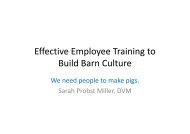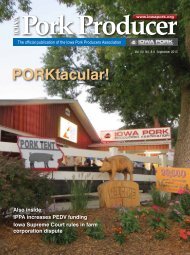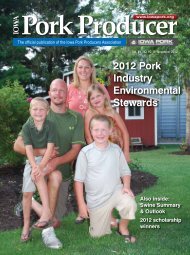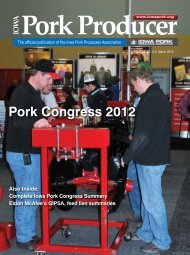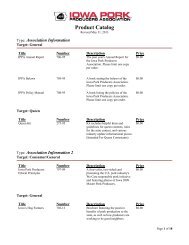September 2011 - Iowa Pork Producers Association
September 2011 - Iowa Pork Producers Association
September 2011 - Iowa Pork Producers Association
Create successful ePaper yourself
Turn your PDF publications into a flip-book with our unique Google optimized e-Paper software.
News from the<br />
National <strong>Pork</strong> Board<br />
A handful of information for foiling high<br />
costs<br />
Ideas for relief arrived in the mailbox of pork<br />
producers in July. The <strong>Pork</strong> Checkoff sent “Practical<br />
Ideas to Address High Feed and Production Costs,”<br />
a booklet containing ideas for reducing the cost of<br />
feeding pigs during this time of high production costs.<br />
The booklet consists of two sections. Divided into<br />
different areas of production, the first section<br />
shares tips on topics from feed processing and<br />
manufacturing to marketing. The second section<br />
contains a brief description of <strong>Pork</strong> Checkoff-funded<br />
research in areas relevant to feed and production<br />
costs and has a link to get more detailed information.<br />
In a cover letter attached to the booklet, National<br />
<strong>Pork</strong> Board President Everett Forkner said he wanted<br />
to assure America’s pork producers that the <strong>Pork</strong><br />
Checkoff continues to work to find answers to the<br />
tough questions brought on by the high prices and<br />
uncertainty about this year’s feed crops.<br />
“Whether it’s looking at the real-time challenges,<br />
such as monitoring herd health for efficiencyrobbing<br />
diseases, or seeking answers to longer term<br />
issues such as sow lifetime productivity, Checkoff is<br />
involved in the frontline of research,” he said.<br />
If you are interested in a copy of the booklet and did not<br />
receive one, or for additional information, simply visit<br />
pork.org for the online version or call (515) 456-7675.<br />
PRRS’ costs to pork industry increasing<br />
A new study estimates that porcine reproductive<br />
and respiratory syndrome (PRRS) continues to be a<br />
major drag on the U.S. pork industry - costing the<br />
pork industry $641 million per year. This translates<br />
into $1.8 million per day or $114.71 per sow<br />
annually.<br />
A previous economic study in 2005 calculated PRRS<br />
losses at $560 million annually.<br />
The study was underwritten by the <strong>Pork</strong> Checkoff<br />
and conducted by <strong>Iowa</strong> State University.<br />
“This Checkoff-funded work offers producers,<br />
veterinarians and every part of the pork chain a new<br />
and valuable insight into the economic impact of<br />
PRRS and underscores why we’ve leveraged domestic<br />
and international government funds to offer<br />
producers tools for regional control of this virus,”<br />
said National <strong>Pork</strong> Board President Everett Forkner,<br />
a producer from Richards, Mo.<br />
The <strong>2011</strong> study differed most significantly from the<br />
2005 study in the allocation of losses between the<br />
breeding and the growing pig herds. Specifically,<br />
losses in the growing pig herd accounted for 88<br />
percent of the total cost of PRRS in the 2005 study<br />
compared with 55 percent in the current analysis.<br />
New oral fluid collection resource available<br />
A new nine-minute DVD, Oral Fluid Collection<br />
in Pigs, guides swine health experts and producers<br />
through the step-by-step process of collecting,<br />
labeling, processing and shipping oral fluid samples<br />
to a diagnostic lab.<br />
USDA provided funding for the DVD, and the<br />
<strong>Pork</strong> Checkoff collaborated on the project. The<br />
<strong>Pork</strong> Checkoff has funded several research projects<br />
involving the development and validation of oral<br />
fluids as an alternative to collecting serum or blood<br />
for disease diagnoses.<br />
“This is the latest tool available to show veterinarians<br />
and producers how to properly collect samples<br />
that can help detect multiple swine pathogens, said<br />
Lisa Becton, Checkoff director of swine health.<br />
“Pathogens now detectable via oral-fluid sampling<br />
include influenza, PRRS, porcine circovirus and<br />
mycoplasma.”<br />
38 SEPTEMBER <strong>2011</strong>




